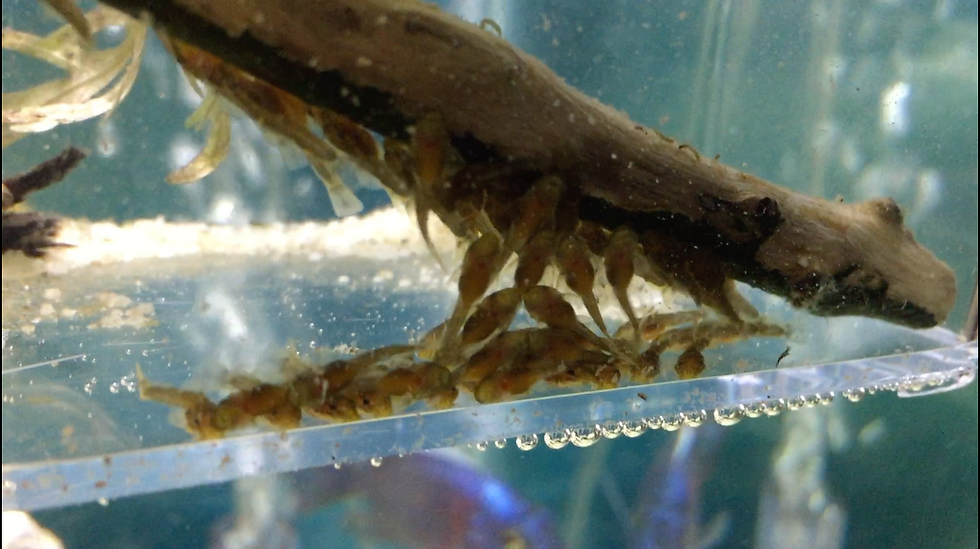Video Journal
BAP Ancistrus, Bristlenose Plecos
Species
Ancistrus
Bristlenose Pleco
Reproduction
Method of Reproduction: Egg Layer
Number and Gender Distribution of Parents: Single Pair
Origin of Parents: Tank Raised (Purchased from LFS)
Approximate number of fry: ca. 60
Date of Birth: Eggs hatched (12/12/2019)
Approx. Number of Fry at 30 Days: ca. 60
Aquarium Conditions
Breeding Tank:
pH — 7.8
GH — 179 ppm
KH — 53.7 ppm
Temperature: 78-degrees Fahrenheit
Average Nitrate: 10-60 ppm (weekly water changes)
Aquarium Size: in inches, 48.25” long x 12.75” front to back x 21” tall— 55 gal. long
Water Source: town / city water
Water Changes: 40% 1x per week
Filtration System: Two large sponge filters, Two Aqueon 75 hang on back filters with Pothos growing out
[Initial] Grow-out Tank:
pH — 7.5
GH — 89.5 ppm
KH — 35.8 ppm
Temperature: 82-degrees Fahrenheit
Average Nitrate: 10-40 ppm (weekly water changes)
Aquarium Size: in inches, 16” long x 8" front to back x 10” tall— 5.5 gal.
Water Source: town / city water
Water Changes: 60% 1x per week
Filtration System: One small sponge filter
Decor & Environment
Breeding Tank:
Live Plants: No live plants in the aquarium, only Pothos growing out of hang on back filters
Caves of Similar Hiding Places: Texas Holey Rock, Large Conch Shells
Substrate: Fine white gravel (appears like sand)
Lighting Type and Timing: LED that comes on 55 gal. kit hoods
[Initial] Grow-out Tank:
Live Plants: Java Fern
Caves of Similar Hiding Places: Large pieces of wood (for the small tank size) afford hiding places and cover
Substrate: none
Lighting Type and Timing: the small LED that comes on the kit hood
Feeding
Food Fed to Parents and How Often: BNP parents eat algae that grows on the Texas Holey Rock and glass. We also feed Omega One Veggie Micro Pellets along with other staple Cichlid flakes and Pellets 2x / day
Food Fed to Fry and How Often: 2x / day — Omega One Veggie Rounds, boiled slices of Zucchini (green squash), Occasional Sera-O-Nip tab, ample wood and oak leaf litter for fry to gnaw on
Photos












Comments & Additional Information
We have always kept at least one Bristlenose Pleco in each of our tanks that are 20 gallons or larger. We started out with our African Cichlids a year ago, bought a bright assortment of young Mbuna, and tossed in three Bristlenose Plecos to help cut down on algae growth. They do keep the tank spotless. Because we feed our Cichlids a variety of foods, including Omega One veggie micro pellets, the Plecos are well-supplied with a rounded diet.
Beginning about four months ago, we discovered that one of our plecos was starting to grow out his cupule mouth structure. Very quickly, we observed that he had found a narrow crack in the Texas Holey Rock, and was wooing in a female. They spawned, and we eagerly watched as the eggs hatched. However, in a fully stocked African Cichlid tank, it is difficult for fry to survive. We watched this scenario happen twice - requesting advice from more experienced breeders in PVAS - and finally determined to pull the eggs.
Pulling BNP eggs proved challenging. They were laid in a tricky little crack at the bottom of a 100-lb. chunk of Texas Holey Rock. We had to use a siphon to scrape them loose, and draw them down into a specimen container suspended over a pail.
Once set up in the specimen container with a bubbler, and touch of H2O2 (ca. 1/2 ml.), they all hatched beautifully in five days, and the rest is history. They ate off their yolk sack for a few days more. We put in some Wisteria and wood which they all took to.
We were advised to get them into a tank with a lot of wood! We built a little 5.5 gal. grow-out tank with a sponge filter, bare bottom, java fern, and loads of wood. The Plecos absolutely love boiled zucchini, but need some food with protein in too. We feed Omega One Veggie Rounds, some sera micron dissolved in water, and an occasional Sera-O-Nip tab (krill-based, heavy protein).
Within about three weeks, we began to distribute the growing BNP fry to other tanks. 20 of them went to a 55 gal, housing a large grow-out population of German Blue Rams. 10 of them went to a 40 gal breeder housing a mixed grow-out population of Auratus and Kribensis fry. Another 10 went to a 20 gal.-long where a younger batch of rams is growing out. The key to every tank they are moved into is the presence of ample aged wood.

I will also be adding an additional 5 points for your detailed video.